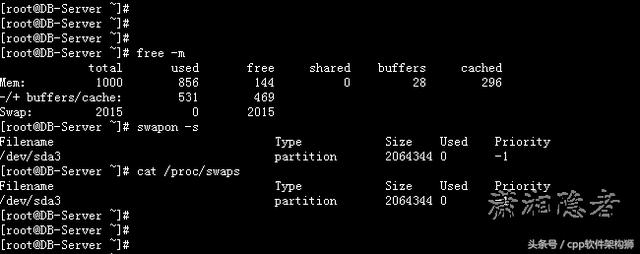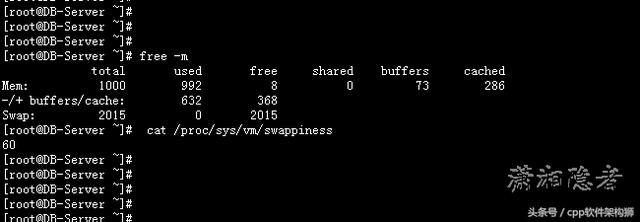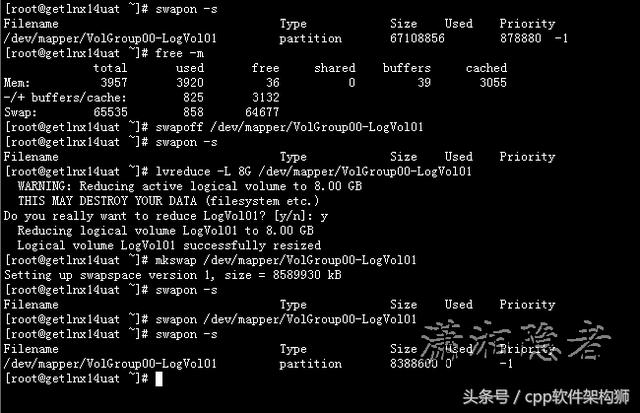Swap交换分区概念
发布时间:2018-11-28 15:16:04编辑:丝画阁阅读(1193)
什么是Linux swap space呢?我们先来看看下面两段关于Linux swap space的英文介绍资料:
Linux divides its physical RAM (random access memory) into chucks of memory called pages. Swapping is the process whereby a page of memory is copied to the preconfigured space on the hard disk, called swap space, to free up that page of memory. The combined sizes of the physical memory and the swap space is the amount of virtual memory available.
Swap space in Linux is used when the amount of physical memory (RAM) is full. If the system needs more memory resources and the RAM is full, inactive pages in memory are moved to the swap space. While swap space can help machines with a small amount of RAM, it should not be considered a replacement for more RAM. Swap space is located on hard drives, which have a slower access time than physical memory.Swap space can be a dedicated swap partition (recommended), a swap file, or a combination of swap partitions and swap files.
Linux内核为了提高读写效率与速度,会将文件在内存中进行缓存,这部分内存就是Cache Memory(缓存内存)。即使你的程序运行结束后,Cache Memory也不会自动释放。这就会导致你在Linux系统中程序频繁读写文件后,你会发现可用物理内存变少。当系统的物理内存不够用的时候,就需要将物理内存中的一部分空间释放出来,以供当前运行的程序使用。那些被释放的空间可能来自一些很长时间没有什么操作的程序,这些被释放的空间被临时保存到Swap空间中,等到那些程序要运行时,再从Swap分区中恢复保存的数据到内存中。这样,系统总是在物理内存不够时,才进行Swap交换。
关于Swap分区,其实我们有很多疑问,如果能弄清楚这些疑问,那么你对Swap的了解掌握就差不多了。如何查看Swap分区大小? Swap分区大小应该如何设置?系统在什么时候会使用Swap分区? 是否可以调整? 如何调整Swap分区的大小?Swap分区有什么优劣和要注意的地方? Swap分区是否必要?那么我一个一个来看看这些疑问吧!
查看Swap分区大小
查看Swap分区的大小以及使用情况,一般使用free命令即可,如下所示,Swap大小为2015M,目前没有使用Swap分区
[root@DB-Server ~]# free -m total used free shared buffers cached Mem: 1000 855 145 0 28 296 -/+ buffers/cache: 530 470 Swap: 2015 0 2015
另外我们还可以使用swapon命令查看当前swap相关信息:例如swap空间是swap partition,Swap size,使用情况等详细信息
[root@DB-Server ~]# swapon -s Filename Type Size Used Priority /dev/sda3 partition 2064344 0 -1 [root@DB-Server ~]# cat /proc/swaps Filename Type Size Used Priority /dev/sda3 partition 2064344 0 -1 [root@DB-Server ~]#

Swap分区大小设置
系统的Swap分区大小设置多大才是最优呢? 关于这个问题,应该说只能有一个统一的参考标准,具体还应该根据系统实际情况和内存的负荷综合考虑,像ORACLE的官方文档就推荐如下设置,这个是根据物理内存来做参考的。
RAM
Swap Space
Up to 512 MB
2 times the size of RAM
Between 1024 MB and 2048 MB
1.5 times the size of RAM
Between 2049 MB and 8192 MB
Equal to the size of RAM
More than 8192 MB
0.75 times the size of RAM
另外在其它博客中看到下面一个推荐设置,当然我不清楚其怎么得到这个标准的。是否合理也无从考证。可以作为一个参考。
4G以内的物理内存,SWAP 设置为内存的2倍。
4-8G的物理内存,SWAP 等于内存大小。
8-64G 的物理内存,SWAP 设置为8G。
64-256G物理内存,SWAP 设置为16G。
上下两个标准确实也很让人无所适从。我就有一次在一台ORACLE数据库服务器(64G的RAM),按照官方推荐设置了一个很大的Swap分区,但是我发现其实这个Swap几乎很少用到,其实是浪费了磁盘空间。所以如果根据系统实际情况和内存的负荷综合考虑,其实应该按照第二个参考标准设置为8G即可。当然这个只是个人的一些认知。
释放Swap分区空间
[root@testlnx ~]# free -m total used free shared buffers cached Mem: 64556 55368 9188 0 926 51405 -/+ buffers/cache: 3036 61520 Swap: 65535 13 65522 [root@testlnx ~]# swapon -s Filename Type Size Used Priority /dev/mapper/VolGroup00-LogVol01 partition 67108856 14204 -1
使用swapoff关闭交换分区
[root@testlnx ~]# swapoff /dev/mapper/VolGroup00-LogVol01
使用swapon启用交换分区,此时查看交换分区的使用情况,你会发现used为0了
[root@testlnx ~]# swapon /dev/mapper/VolGroup00-LogVol01 [root@testlnx ~]# free -m total used free shared buffers cached Mem: 64556 55385 9171 0 926 51406 -/+ buffers/cache: 3052 61504 Swap: 65535 0 65535 [root@testlnx ~]#
Swap分区空间什么时候使用
系统在什么情况或条件下才会使用Swap分区的空间呢? 其实是Linux通过一个参数swappiness来控制的。当然还涉及到复杂的算法。
这个参数值可为 0-100,控制系统 swap 的使用程度。高数值可优先系统性能,在进程不活跃时主动将其转换出物理内存。低数值可优先互动性并尽量避免将进程转换处物理内存,并降低反应延迟。默认值为 60。注意:这个只是一个权值,不是一个百分比值,涉及到系统内核复杂的算法。关于该参数请参考这篇文章[转载]调整虚拟内存,在此不做过多赘述。下面是关于swappiness的相关资料
The Linux 2.6 kernel added a new kernel parameter called swappiness to let administrators tweak the way Linux swaps. It is a number from 0 to 100. In essence, higher values lead to more pages being swapped, and lower values lead to more applications being kept in memory, even if they are idle. Kernel maintainer Andrew Morton has said that he runs his desktop machines with a swappiness of 100, stating that "My point is that decreasing the tendency of the kernel to swap stuff out is wrong. You really don't want hundreds of megabytes of BloatyApp's untouched memory floating about in the machine. Get it out on the disk, use the memory for something useful."
Swappiness is a property of the Linux kernel that changes the balance between swapping out runtime memory, as opposed to dropping pages from the system page cache. Swappiness can be set to values between 0 and 100 inclusive. A low value means the kernel will try to avoid swapping as much as possible where a higher value instead will make the kernel aggressively try to use swap space. The default value is 60, and for most desktop systems, setting it to 100 may affect the overall performance, whereas setting it lower (even 0) may improve interactivity (by decreasing response latency.
有两种临时修改swappiness参数的方法,系统重启后失效
方法1: [root@DB-Server ~]# more /proc/sys/vm/swappiness 60 [root@DB-Server ~]# echo 10 > /proc/sys/vm/swappiness [root@DB-Server ~]# more /proc/sys/vm/swappiness 10 方法2 [root@DB-Server ~]#sysctl vm.swappiness=10
永久修改swappiness参数的方法就是在配置文件/etc/sysctl.conf里面修改vm.swappiness的值,然后重启系统
echo 'vm.swappiness=10' >>/etc/sysctl.conf
如果有人会问是否物理内存使用到某个百分比后才会使用Swap交换空间,可以明确的告诉你不是这样一个算法,如下截图所示,及时物理内存只剩下8M了,但是依然没有使用Swap交换空间,而另外一个例子,物理内存还剩下19G,居然用了一点点Swap交换空间。


另外调整/proc/sys/vm/swappiness这个参数,如果你没有绝对把握,就不要随便调整这个内核参数,这个参数符合大多数情况下的一个最优值。
Swap交换分区对性能的影响
我们知道Linux可以使用文件系统中的一个常规文件或独立分区作为Swap交换空间,相对而言,交换分区要快一些。但是和RAM比较而言,Swap交换分区的性能依然比不上物理内存,目前的服务器上RAM基本上都相当充足,那么是否可以考虑抛弃Swap交换分区,是否不需要保留Swap交换分区呢?这个其实是我的疑问之一。在这篇What Is a Linux SWAP Partition, And What Does It Do?博客中,作者给出了swap交换空间的优劣
Advantages:
- Provides overflow space when your memory fills up completely
- Can move rarely-needed items away from your high-speed memory
- Allows you to hibernate
Disadvantages:
- Takes up space on your hard drive as SWAP partitions do not resize dynamically
- Can increase wear and tear to your hard drive
- Does not necessarily improve performance (see below)
其实保留swap分区概括起来可以从下面来看:
首先,当物理内存不足以支撑系统和应用程序(进程)的运作时,这个Swap交换分区可以用作临时存放使用率不高的内存分页,把腾出的内存交给急需的应用程序(进程)使用。有点类似机房的UPS系统,虽然正常情况下不需要使用,但是异常情况下, Swap交换分区还是会发挥其关键作用。
其次,即使你的服务器拥有足够多的物理内存,也有一些程序会在它们初始化时残留的极少再用到的内存分页内容转移到 swap 空间,以此让出物理内存空间。对于有发生内存泄漏几率的应用程序(进程),Swap交换分区更是重要,因为谁也不想看到由于物理内存不足导致系统崩溃。
最后,现在很多个人用户在使用Linux,有些甚至是PC的虚拟机上跑Linux系统,此时可能常用到休眠(Hibernate),这种情况下也是推荐划分Swap交换分区的。
其实少量使用Swap交换空间是不会影响性能,只有当RAM资源出现瓶颈或者内存泄露,进程异常时导致频繁、大量使用交换分区才会导致严重性能问题。另外使用Swap交换分区频繁,还会引起kswapd0进程(虚拟内存管理中, 负责换页的)耗用大量CPU资源,导致CPU飙升。
关于Swap分区的优劣以及是否应该舍弃,我有点恶趣味的想到了这个事情:人身上的两个器官,阑尾和扁桃体。切除阑尾或扁桃体是否也是争论不休。另外,其实不要Swap交换分区,Linux也是可以正常运行的(有人提及过这个问题)
调整Swap分区的大小
如下测试案例所示,Swap分区大小为65535M,我现在想将Swap分区调整为8G,那么我们来看看具体操作吧
1:查看Swap的使用情况以及相关信息
[root@getlnx14uat ~]# swapon -s Filename Type Size Used Priority /dev/mapper/VolGroup00-LogVol01 partition 67108856 878880 -1 [root@getlnx14uat ~]# free -m total used free shared buffers cached Mem: 3957 3920 36 0 39 3055 -/+ buffers/cache: 825 3132 Swap: 65535 858 64677
2: 关闭Swap交换分区
[root@getlnx14uat ~]# swapoff /dev/mapper/VolGroup00-LogVol01 [root@getlnx14uat ~]# swapon -s Filename Type Size Used Priority
3: 这里是缩小Swap分区大小,如果是增大Swap分区大小,那么就需要扩展正在使用的swap分区的逻辑卷,此处使用lvreduce命令收缩逻辑卷。
[root@getlnx14uat ~]# lvreduce -L 8G /dev/mapper/VolGroup00-LogVol01 WARNING: Reducing active logical volume to 8.00 GB THIS MAY DESTROY YOUR DATA (filesystem etc.) Do you really want to reduce LogVol01? [y/n]: y Reducing logical volume LogVol01 to 8.00 GB Logical volume LogVol01 successfully resized
4:格式化swap分区
[root@getlnx14uat ~]# mkswap /dev/mapper/VolGroup00-LogVol01 Setting up swapspace version 1, size = 8589930 kB
5:启动swap分区,并增加到/etc/fstab自动挂载
[root@getlnx14uat ~]# swapon -s Filename Type Size Used Priority [root@getlnx14uat ~]# swapon /dev/mapper/VolGroup00-LogVol01 [root@getlnx14uat ~]# swapon -s Filename Type Size Used Priority /dev/mapper/VolGroup00-LogVol01 partition 8388600 0 -1

参考资料:
https://wiki.archlinux.org/index.php/swap
http://blog.csdn.net/tianlesoftware/article/details/8741873
http://www.makeuseof.com/tag/swap-partition/
关键字:
上一篇:渗透常用SQL注入语句大全
下一篇:nginx可以优化的地方介绍